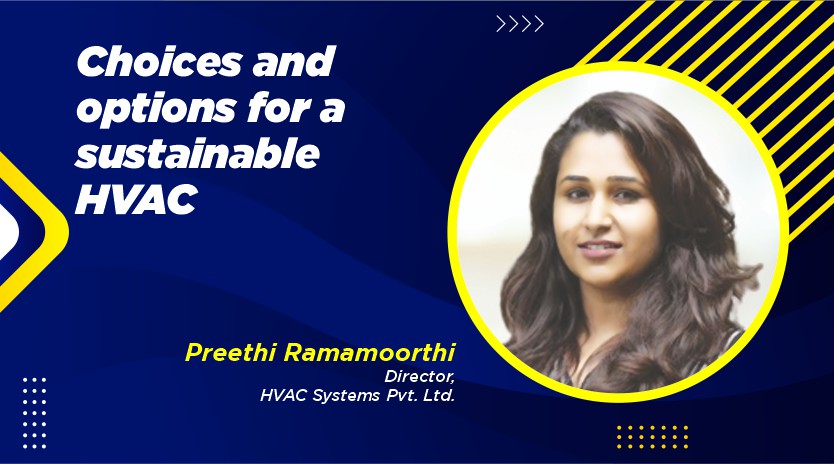The future is inclining towards green building certification, sustainability, and ecofriendly concepts. Various options and newer technologies are available, and can be incorporated into the design parameters of ongoing projects, says Preethi Ramamoorthi, Director, HVAC Systems Pvt. Ltd.
In the HVAC industry, eco-friendly sustainability and the IGBT certification are something every company and organisation strives for – in general. For the recent ongoing projects, various options, including newer technologies in the design parameters, come under the consultation domain of the HVAC design process. The crux of the matter is the long-term viability of our entire HVAC system.
Sustainability depends on the design and the product selection. Foremost, it is the equipment selection and application of the HVAC for a particular project. Incidental to the scheme of things is the maintenance aspect. For many years installed HVAC systems in our country have been in operation. Those systems need maintenance, and retrofit is a probable one looking at options. Every organisation is doing retrofit jobs to bring them under the banner of being sustainable and environmentally friendly. Ultimately, the changed makeover is also dependent on energy source selection.
Sustainability
Sustainability is not a novel concept. That is something that every manufacturer, consultant, and service provider strives for while providing specific solutions which is sustainable for future generations. Sustainability includes environmental, economic, and social dimensions, all rolled into one industry. The design parameters are critical ones that lead to sustainability. Organisations like ISHRAE, ASHRAE, and IGBC investigate these parameters and design guidelines as the industry evolves daily. The guidebook is also developing alongside the outcomes. Secondly, product selection is also vital. Understanding the technicality behind every product could be as simple as a single split unit to a chiller. The industry includes multiple OEMs with various variants, solutions, and refrigerants. The product selection process, as well as the technical aspects that follow, are critical. The most important aspect of sustainability or HVAC being environmentally friendly falls under the primary category of maintenance. Though, many clients don’t realise how important it is. They believe that if the system is installed, it must run on its own; the importance of maintenance, particularly the parameters in maintenance activities, is crucial.
In present times, leaning towards green building certification, sustainability, and the eco-friendly concept is being observed. And to move toward sustainability, the main conclusion is to educate clients and industry colleagues with evolving new ideas and solutions.
Looking ahead
The continual shift is observed in the evolution of various refrigerants and retrofits. Retrofit and maintenance are inextricably linked. Regarding retrofitting jobs, a few solutions are available where we can replace the refrigerant gas, like R-22, if the equipment supports this transformation or change. That is one of the significant aspects. OEMs have also taken a step forward, and every component, like plastic components in the machine, has now been shifted to CFC plastic, which is reusable plastic (CFCs are also used in producing many foamed plastics). Recyclable coils and other materials also exist. Many OEM components in systems that are used only once are also recyclable. As a result, the industry is making a concerted effort to ensure the long term viability of the projects.
Last but not least, using solar energy instead of regular electricity is the most sustainable source of energy consumption. Other forms of energy usage around the world include geothermal and hydropower. These are some of the innumerable steps for an industry to move toward a more environmentally friendly and sustainable future. The wholesome aspect of optimising any system in a building is the accumulation of the various entity solutions that can be integrated, and monitoring it with the various software, IoT objects, and sensors can be a beacon for the industry to be more sustainable and environmentally friendly.
Cookie Consent
We use cookies to personalize your experience. By continuing to visit this website you agree to our Terms & Conditions, Privacy Policy and Cookie Policy.














